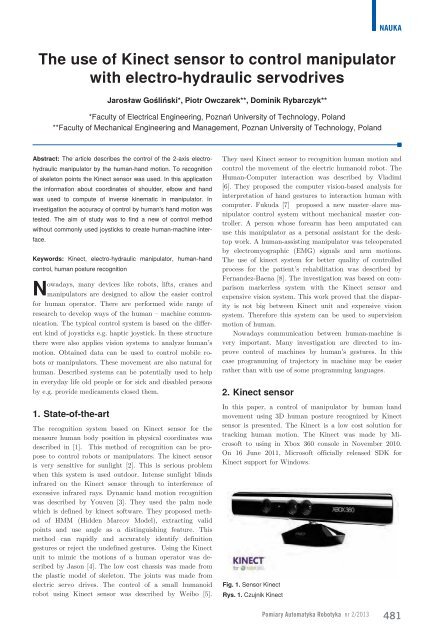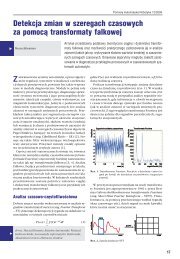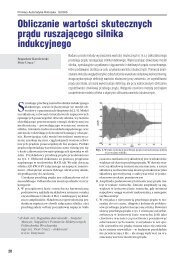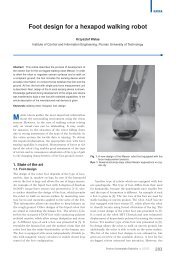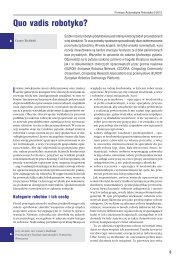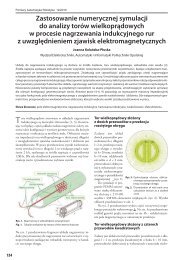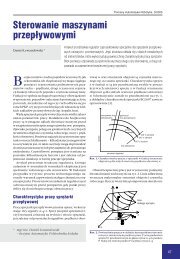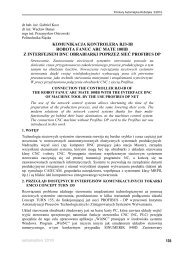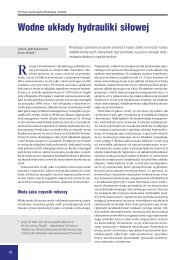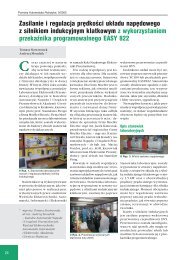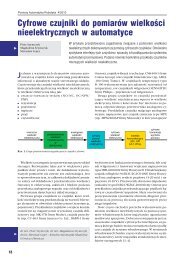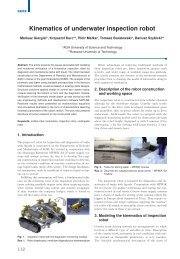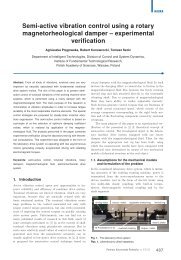The use of Kinect sensor to control manipulator with electro ... - PAR
The use of Kinect sensor to control manipulator with electro ... - PAR
The use of Kinect sensor to control manipulator with electro ... - PAR
Create successful ePaper yourself
Turn your PDF publications into a flip-book with our unique Google optimized e-Paper software.
NAUKA<br />
<strong>The</strong> <strong>use</strong> <strong>of</strong> <strong>Kinect</strong> <strong>sensor</strong> <strong>to</strong> <strong>control</strong> manipula<strong>to</strong>r<br />
<strong>with</strong> <strong>electro</strong>-hydraulic servodrives<br />
Jarosław Gośliński*, Piotr Owczarek**, Dominik Rybarczyk**<br />
*Faculty <strong>of</strong> Electrical Engineering, Poznań University <strong>of</strong> Technology, Poland<br />
**Faculty <strong>of</strong> Mechanical Engineering and Management, Poznan University <strong>of</strong> Technology, Poland<br />
Abstract: <strong>The</strong> article describes the <strong>control</strong> <strong>of</strong> the 2-axis <strong>electro</strong>hydraulic<br />
manipula<strong>to</strong>r by the human-hand motion. To recognition<br />
<strong>of</strong> skele<strong>to</strong>n points the <strong>Kinect</strong> <strong>sensor</strong> was <strong>use</strong>d. In this application<br />
the information about coordinates <strong>of</strong> shoulder, elbow and hand<br />
was <strong>use</strong>d <strong>to</strong> compute <strong>of</strong> inverse kinematic in manipula<strong>to</strong>r. In<br />
investigation the accuracy <strong>of</strong> <strong>control</strong> by human's hand motion was<br />
tested. <strong>The</strong> aim <strong>of</strong> study was <strong>to</strong> find a new <strong>of</strong> <strong>control</strong> method<br />
<strong>with</strong>out commonly <strong>use</strong>d joysticks <strong>to</strong> create human-machine interface.<br />
Keywords: <strong>Kinect</strong>, <strong>electro</strong>-hydraulic manipula<strong>to</strong>r, human-hand<br />
<strong>control</strong>, human posture recognition<br />
N<br />
owadays, many devices like robots, lifts, cranes and<br />
manipula<strong>to</strong>rs are designed <strong>to</strong> allow the easier <strong>control</strong><br />
for human opera<strong>to</strong>r. <strong>The</strong>re are performed wide range <strong>of</strong><br />
research <strong>to</strong> develop ways <strong>of</strong> the human – machine communication.<br />
<strong>The</strong> typical <strong>control</strong> system is based on the different<br />
kind <strong>of</strong> joysticks e.g. haptic joystick. In these structure<br />
there were also applies vision systems <strong>to</strong> analyze human’s<br />
motion. Obtained data can be <strong>use</strong>d <strong>to</strong> <strong>control</strong> mobile robots<br />
or manipula<strong>to</strong>rs. <strong>The</strong>se movement are also natural for<br />
human. Described systems can be potentially <strong>use</strong>d <strong>to</strong> help<br />
in everyday life old people or for sick and disabled persons<br />
by e.g. provide medicaments closed them.<br />
1.State-<strong>of</strong>-the-art<br />
<strong>The</strong> recognition system based on <strong>Kinect</strong> <strong>sensor</strong> for the<br />
measure human body position in physical coordinates was<br />
described in [1]. This method <strong>of</strong> recognition can be propose<br />
<strong>to</strong> <strong>control</strong> robots or manipula<strong>to</strong>rs. <strong>The</strong> kinect <strong>sensor</strong><br />
is very sensitive for sunlight [2]. This is serious problem<br />
when this system is <strong>use</strong>d outdoor. Intense sunlight blinds<br />
infrared on the <strong>Kinect</strong> <strong>sensor</strong> through <strong>to</strong> interference <strong>of</strong><br />
excessive infrared rays. Dynamic hand motion recognition<br />
was described by Youven [3]. <strong>The</strong>y <strong>use</strong>d the palm node<br />
which is defined by kinect s<strong>of</strong>tware. <strong>The</strong>y proposed method<br />
<strong>of</strong> HMM (Hidden Marcov Model), extracting valid<br />
points and <strong>use</strong> angle as a distinguishing feature. This<br />
method can rapidly and accurately identify definition<br />
gestures or reject the undefined gestures. Using the <strong>Kinect</strong><br />
unit <strong>to</strong> mimic the motions <strong>of</strong> a human opera<strong>to</strong>r was described<br />
by Jason [4]. <strong>The</strong> low cost chassis was made from<br />
the plastic model <strong>of</strong> skele<strong>to</strong>n. <strong>The</strong> joints was made from<br />
electric servo drives. <strong>The</strong> <strong>control</strong> <strong>of</strong> a small humanoid<br />
robot using <strong>Kinect</strong> <strong>sensor</strong> was described by Weibo [5].<br />
<strong>The</strong>y <strong>use</strong>d <strong>Kinect</strong> <strong>sensor</strong> <strong>to</strong> recognition human motion and<br />
<strong>control</strong> the movement <strong>of</strong> the electric humanoid robot. <strong>The</strong><br />
Human-Computer interaction was described by Vladimi<br />
[6]. <strong>The</strong>y proposed the computer vision-based analysis for<br />
interpretation <strong>of</strong> hand gestures <strong>to</strong> interaction human <strong>with</strong><br />
computer. Fukuda [7] proposed a new master–slave manipula<strong>to</strong>r<br />
<strong>control</strong> system <strong>with</strong>out mechanical master <strong>control</strong>ler.<br />
A person whose forearm has been amputated can<br />
<strong>use</strong> this manipula<strong>to</strong>r as a personal assistant for the desk<strong>to</strong>p<br />
work. A human-assisting manipula<strong>to</strong>r was teleoperated<br />
by <strong>electro</strong>myographic (EMG) signals and arm motions.<br />
<strong>The</strong> <strong>use</strong> <strong>of</strong> kinect system for better quality <strong>of</strong> <strong>control</strong>led<br />
process for the patient’s rehabilitation was described by<br />
Fernandez-Baena [8]. <strong>The</strong> investigation was based on comparison<br />
markerless system <strong>with</strong> the <strong>Kinect</strong> <strong>sensor</strong> and<br />
expensive vision system. This work proved that the disparity<br />
is not big between <strong>Kinect</strong> unit and expensive vision<br />
system. <strong>The</strong>refore this system can be <strong>use</strong>d <strong>to</strong> supervision<br />
motion <strong>of</strong> human.<br />
Nowadays communication between human-machine is<br />
very important. Many investigation are directed <strong>to</strong> improve<br />
<strong>control</strong> <strong>of</strong> machines by human's gestures. In this<br />
case programming <strong>of</strong> trajec<strong>to</strong>ry in machine may be easier<br />
rather than <strong>with</strong> <strong>use</strong> <strong>of</strong> some programming languages.<br />
2.<strong>Kinect</strong> <strong>sensor</strong><br />
In this paper, a <strong>control</strong> <strong>of</strong> manipula<strong>to</strong>r by human hand<br />
movement using 3D human posture recognized by <strong>Kinect</strong><br />
<strong>sensor</strong> is presented. <strong>The</strong> <strong>Kinect</strong> is a low cost solution for<br />
tracking human motion. <strong>The</strong> <strong>Kinect</strong> was made by Micros<strong>of</strong>t<br />
<strong>to</strong> using in Xbox 360 console in November 2010.<br />
On 16 June 2011, Micros<strong>of</strong>t <strong>of</strong>ficially released SDK for<br />
<strong>Kinect</strong> support for Windows.<br />
Fig. 1. Sensor <strong>Kinect</strong><br />
Rys. 1. Czujnik <strong>Kinect</strong><br />
Pomiary Au<strong>to</strong>matyka Robotyka nr 2/2013<br />
481
NAUKA<br />
<strong>Kinect</strong> was the best sold device in the world and has been<br />
entered in<strong>to</strong> the Guinness Book <strong>of</strong> Records as the “fastestselling<br />
consumer <strong>electro</strong>nics device”. 18 million units <strong>of</strong> the<br />
<strong>Kinect</strong> <strong>sensor</strong> had been shipped by January 2012. 8 million<br />
<strong>Kinect</strong> units were sold during its first 60 days on the market<br />
[9].<br />
<strong>Kinect</strong> consist <strong>of</strong>:<br />
− color camera RGB (Red, Green, Blue),<br />
− IR Emitter,<br />
− four directional microphone array,<br />
− tilt mo<strong>to</strong>r.<br />
S<strong>of</strong>tware also provide two option <strong>of</strong> recognition: first is<br />
whole posture <strong>of</strong> human, while standing and the second<br />
one is a sitting posture <strong>of</strong> human. In second option, <strong>Kinect</strong><br />
does not require <strong>to</strong> see a lower part <strong>of</strong> human body, which<br />
are e.g. legs.<br />
3.<strong>The</strong> structure <strong>of</strong> the <strong>control</strong> system<br />
<strong>The</strong> structure <strong>of</strong> testbed was shown on scheme block diagram<br />
in fig. 6. <strong>The</strong> system consist <strong>of</strong> <strong>electro</strong> hydraulic<br />
manipula<strong>to</strong>r (figs. 4, 5, 7), PLC (Programmable Logic<br />
Controller), PC computer and vision system like <strong>Kinect</strong>.<br />
PLC was <strong>use</strong>d <strong>to</strong> <strong>control</strong>led the 2-axis manipula<strong>to</strong>r, the<br />
working area <strong>of</strong> it is shown in fig. 4. In manipula<strong>to</strong>r, incremental<br />
encoders were <strong>use</strong>d <strong>to</strong> measure tilt angles. This<br />
encoders were placed in joints <strong>of</strong> manipula<strong>to</strong>r. <strong>The</strong> resolution<br />
<strong>of</strong> measurement system was 14 400 point per one<br />
rotation <strong>with</strong> quadrature signal.<br />
Fig. 2. <strong>The</strong> construction <strong>of</strong> <strong>Kinect</strong><br />
Rys. 2. Konstrukcja konsoli <strong>Kinect</strong><br />
<strong>The</strong> first <strong>of</strong> cameras is a standard RGB video camera <strong>with</strong><br />
resolution 640 × 480. This camera captures the frame and is<br />
<strong>use</strong>d <strong>to</strong> e.g. face recognition. <strong>The</strong> second camera is a depht<br />
<strong>sensor</strong>. It has got resolution <strong>of</strong> 300 × 200 points. This <strong>sensor</strong><br />
can measure distanse from range <strong>of</strong> about 0,4 m <strong>to</strong> 6,5 m.<br />
System provide human posture recognition in this range<br />
using this field <strong>of</strong> depth points. <strong>Kinect</strong> should be <strong>use</strong>d in<br />
indoor application, beca<strong>use</strong> <strong>sensor</strong> is sensitive on sun light.<br />
An array <strong>of</strong> microphone is <strong>use</strong>d <strong>to</strong> speech recognition.<br />
Four microphones are <strong>use</strong>d <strong>to</strong> filtering signal, which<br />
provides cut <strong>of</strong>f background noise.<br />
A s<strong>of</strong>tware <strong>of</strong> <strong>Kinect</strong> <strong>use</strong> information from camera and<br />
depth <strong>sensor</strong> <strong>to</strong> provide all coordination points <strong>of</strong> human<br />
skele<strong>to</strong>n which are shown in fig. 3.<br />
Fig. 4. <strong>The</strong> working area <strong>of</strong> the manipula<strong>to</strong>r<br />
Rys. 4. Obszar roboczy manipula<strong>to</strong>ra<br />
Fig. 3. <strong>The</strong> recognition points <strong>of</strong> the human skele<strong>to</strong>n<br />
Fig. 3. <strong>The</strong> recognition points <strong>of</strong> the human skele<strong>to</strong>n<br />
Rys. 3. Rozpoznawane punkty ludzkiego szkieletu<br />
Rys 3 Rozpoznawane punkty ludzkiego szkieletu<br />
Fig. 5. <strong>The</strong> dimensions <strong>of</strong> the manipula<strong>to</strong>r<br />
Rys. 5. Wymiary manipula<strong>to</strong>ra<br />
482
Fig. 6. Schem diagram <strong>of</strong> the testbed<br />
Rys. 6. Schemat blokowy stanowiska badawczego<br />
1. <strong>The</strong> Electro-hydraulic manipula<strong>to</strong>r<br />
and shoulder <strong>of</strong> human coordinate <strong>to</strong> compute the scale<br />
between points <strong>of</strong> screen in meters. <strong>The</strong> length between<br />
shoulder and hand <strong>of</strong> the opera<strong>to</strong>r has been <strong>use</strong>d <strong>to</strong> calculate<br />
inverse kinematic. <strong>The</strong> motion <strong>of</strong> human hand was<br />
mapped by manipula<strong>to</strong>r.<br />
β<br />
2. Actua<strong>to</strong>rs<br />
3. Incremental encoders<br />
α<br />
Fig. 7. <strong>The</strong> <strong>electro</strong> hydraulic manipula<strong>to</strong>r<br />
Rys. 7. Manipula<strong>to</strong>ra elektrohydrauliczny<br />
In hydraulic system the ratio <strong>of</strong> force <strong>to</strong> dimension is<br />
the biggest in the world. <strong>The</strong> <strong>use</strong>d hydraulic pis<strong>to</strong>ns can<br />
attain force <strong>of</strong> about 10 kN on the end point <strong>of</strong> the manipula<strong>to</strong>r.<br />
<strong>Kinect</strong> was connected <strong>to</strong> the computer by USB, the<br />
special s<strong>of</strong>tware was installed <strong>to</strong> capture skele<strong>to</strong>n points.<br />
We <strong>use</strong>d this points <strong>to</strong> compute inverse kinematic <strong>of</strong> the<br />
manipula<strong>to</strong>r and send it <strong>to</strong> PLC B&R connected via<br />
TCP/IP (Transmission Control Pro<strong>to</strong>col/Internet Pro<strong>to</strong>col)<br />
<strong>with</strong> PVI Manager (Process Visualization Interface).<br />
<strong>The</strong> PID <strong>control</strong>ler was implemented in PLC and generate<br />
voltage signal in special DAC card (Digital Analog Converter).<br />
This <strong>control</strong> signal changed the velocity <strong>of</strong> movement<br />
<strong>of</strong> hydraulic drives by proportional <strong>control</strong> card.<br />
Fig. 8. <strong>The</strong> geometry <strong>of</strong> the manipula<strong>to</strong>r and opera<strong>to</strong>r’s hand<br />
Rys. 8. Geometria manipula<strong>to</strong>ra i ręki opera<strong>to</strong>ra<br />
<strong>The</strong> cosine theorem has been <strong>use</strong>d in order <strong>to</strong> calculate<br />
inverse kinematic. <strong>The</strong> steps are presented below:<br />
Distance between hand and shoulder<br />
<br />
= ( − ) + ( − )<br />
(1)<br />
2 2<br />
1 3 1 3<br />
Angle γ between line b and base point (shoulder)<br />
4.Calculation <strong>of</strong> coordinates<br />
<strong>The</strong> geometry <strong>of</strong> the whole system was shown in<br />
fig. 8. In order <strong>to</strong> simplify calculation, the original coordinate<br />
system <strong>of</strong> <strong>Kinect</strong> was scaled <strong>to</strong> the coordinate system<br />
in OPEN CV. <strong>The</strong> most important parameters are:<br />
− l1, l2 – the lengths <strong>of</strong> the robot arms,<br />
− x1, y1 – position <strong>of</strong> human hand (robot end point),<br />
− x2, y2 – position <strong>of</strong> human elbow,<br />
− x3, y3 – human shoulder (basis <strong>of</strong> the robot),<br />
− β – angle between robot arms,<br />
− α – angle between the lowest robot arm and the<br />
X axe,<br />
− (0,0) – camera base point (origin).<br />
<strong>The</strong> length <strong>of</strong> elbow is different rather than length <strong>of</strong><br />
<br />
<br />
2 2 2<br />
1 + −<br />
<br />
2<br />
γ = arccos <br />
2<br />
1 <br />
(2)<br />
Angle α1 between line b and first arm <strong>of</strong> the manipula<strong>to</strong>r<br />
l1<br />
( )<br />
α = atan2 − , − (3)<br />
1 3 1 3 1<br />
Angle β from cosine theorem<br />
2 2 2<br />
+ 2 −<br />
<br />
1<br />
β = arccos <br />
2<br />
12 <br />
(4)<br />
Pomiary Au<strong>to</strong>matyka Robotyka nr 2/2013<br />
483
NAUKA<br />
a) b)<br />
Human posture<br />
Inverse<br />
kinematic<br />
<br />
<br />
. <br />
<br />
5.Experimental Tests<br />
<strong>The</strong> aim <strong>of</strong> investigation was the <strong>control</strong> <strong>of</strong> <strong>electro</strong>hydraulic<br />
manipula<strong>to</strong>r by the human hand motion. Many<br />
tests <strong>of</strong> <strong>control</strong> system were performed. <strong>The</strong> screen from<br />
vision system and simulation system were shown in fig. 9<br />
<strong>with</strong> two different positions <strong>of</strong> human-hand. Visualization<br />
<strong>of</strong> manipula<strong>to</strong>r's arm was necessary, beca<strong>use</strong> opera<strong>to</strong>r had<br />
<strong>to</strong> seen the range <strong>of</strong> working area <strong>of</strong> the manipula<strong>to</strong>r. If<br />
this range is not possible <strong>to</strong> achieve, the inverse kinematic<br />
cannot be computed. Opera<strong>to</strong>r was placed before the manipula<strong>to</strong>r<br />
and his right hand was in the same direction as<br />
the end point <strong>of</strong> manipula<strong>to</strong>r (fig. 10).<br />
<strong>The</strong> speed <strong>of</strong> the manipula<strong>to</strong>r’s movements was limited<br />
by flow <strong>of</strong> hydraulic fluid for valve and time delay is visible<br />
between signal from human-hand and the manipula<strong>to</strong>r<br />
(fig. 12). In figures 12 and 13, fast movement <strong>of</strong> the opera<strong>to</strong>r’s<br />
hand and smooth trajec<strong>to</strong>ry <strong>of</strong> the manipula<strong>to</strong>r were<br />
shown. On the end points <strong>of</strong> the movement path an error<br />
can be seen. It occurred, beca<strong>use</strong> the authors <strong>use</strong>d PID<br />
<strong>control</strong>ler <strong>with</strong> settings: K = 30, Kd = 1, Ki = 0.1. With<br />
bigger gains the manipula<strong>to</strong>r achieves errors equal <strong>to</strong> zero,<br />
but the <strong>control</strong> by hand motion was not natural and the<br />
whole manipula<strong>to</strong>r vibrated. This is ca<strong>use</strong>d by not sufficient<br />
precision <strong>of</strong> the depth <strong>sensor</strong> in the <strong>Kinect</strong>. When an<br />
opera<strong>to</strong>r is opposite <strong>to</strong> the <strong>Kinect</strong>, <strong>with</strong>out any movement<br />
and recognition s<strong>of</strong>tware is <strong>use</strong>d, the positions points <strong>of</strong><br />
skele<strong>to</strong>n were changed <strong>with</strong> time.<br />
1. Manipula<strong>to</strong>r<br />
2. PLC<br />
4. Opera<strong>to</strong>r<br />
3. PC<br />
Fig. 10. <strong>The</strong> geometry <strong>of</strong> manipula<strong>to</strong>r and opera<strong>to</strong>r hand<br />
Rys. 10. Geometria manipula<strong>to</strong>ra I ręki opera<strong>to</strong>ra<br />
In experimental test the opera<strong>to</strong>r was doing slow and<br />
In experimental test the opera<strong>to</strong>r was doing slow and<br />
fast motion <strong>of</strong> his hand. <strong>The</strong> first test provide important<br />
fast motion <strong>of</strong> his hand. <strong>The</strong> first test provide important<br />
information about correctness <strong>of</strong> recognition <strong>of</strong> the human<br />
information about correctness <strong>of</strong> recognition <strong>of</strong> the human<br />
posture by <strong>Kinect</strong>. <strong>The</strong> results are bad and have been<br />
posture by <strong>Kinect</strong>. <strong>The</strong> results are bad and have been<br />
shown in fig. 11. Some time, <strong>Kinect</strong> lose the information<br />
shown in fig. 11. Some time, <strong>Kinect</strong> lose the information<br />
about skele<strong>to</strong>n and returns invalid position <strong>of</strong> captured<br />
about skele<strong>to</strong>n and returns invalid position <strong>of</strong> captured<br />
points. To avoid incorrect points the special filter was<br />
points. To avoid incorrect points the special filter was<br />
programmed in range <strong>of</strong> –90…90 degrees <strong>of</strong> angle.<br />
programmed in range <strong>of</strong> –90…90 degrees <strong>of</strong> angle.<br />
Fig. 11. A movement <strong>with</strong> noise<br />
Rys. 11. Ruch z zakłóceniami<br />
484
Fig. 14. A fast motion <strong>of</strong> <strong>control</strong><br />
Rys. 14. Szybki ruch sterowania<br />
Fig. 12. A slowly motion <strong>of</strong> <strong>control</strong><br />
Rys. 12. Wolny ruch sterowania<br />
6.Conclusion<br />
<strong>The</strong> human-hand movement was <strong>use</strong>d <strong>to</strong> <strong>control</strong> <strong>of</strong> the<br />
<strong>electro</strong>-hydraulic manipula<strong>to</strong>r <strong>with</strong> servodrives. <strong>The</strong> human<br />
posture recognition was implement by <strong>Kinect</strong> <strong>sensor</strong>.<br />
<strong>The</strong> necessary points like shoulder, elbow and hand was<br />
<strong>use</strong>d <strong>to</strong> scaled and compute inverse kinematic for manipula<strong>to</strong>r.<br />
<strong>The</strong> investigation prove the <strong>Kinect</strong> can be <strong>use</strong>d <strong>to</strong><br />
<strong>control</strong> any kinds <strong>of</strong> manipula<strong>to</strong>rs, but in case when the<br />
precision <strong>control</strong> is not important. In case the movement<br />
<strong>of</strong> human-hand was s<strong>to</strong>ned, the recognized skele<strong>to</strong>n points<br />
were changed in time, this is biggest disadvantage <strong>of</strong> this<br />
<strong>sensor</strong>. However the price <strong>of</strong> this device is advantage. This<br />
method <strong>of</strong> <strong>control</strong> can be <strong>use</strong>d <strong>to</strong> <strong>control</strong> <strong>of</strong> manipula<strong>to</strong>r,<br />
which can be help sick people <strong>with</strong> any activities <strong>of</strong> everyday<br />
life e.g. give medicaments or rehabilitation activities.<br />
In another case this system can be <strong>use</strong>d <strong>to</strong> program<br />
a trajec<strong>to</strong>ry <strong>of</strong> robots in easier way, rather than joystick.<br />
Acknowledgements<br />
<strong>The</strong> work described in this paper was supported by Polish<br />
Ministry <strong>of</strong> Science and Education in the years 2009 <strong>to</strong><br />
2012 as a grant no. N502 260737.<br />
Fig. 13. An average speed <strong>of</strong> the motion <strong>control</strong><br />
Rys. 13. Średnia prędkość sterowania<br />
Bibliography<br />
1. Xiao Z., Mengyin F., Yi Y., Ningyi L., 3D Human<br />
Postures Recognition Using <strong>Kinect</strong>, [in:] 4 th International<br />
Conference on Intelligent Human-Machine Systems<br />
and Cybernetics 2012.<br />
2. Riyad A. El-Iaithy, Huang J., Yeh M., Study on the<br />
Use <strong>of</strong> Micros<strong>of</strong>t <strong>Kinect</strong> for Robotics Applications.<br />
3. Wang Y., Yang Ch., Wu X., Xu Sh., Li H., <strong>Kinect</strong><br />
Bases Dynamic Hand Gesture Recognitio Algorithm<br />
Pomiary Au<strong>to</strong>matyka Robotyka nr 2/2013<br />
485
NAUKA<br />
Research, 4 th International Conference on Intelligent<br />
Human-Machine Systems and Cybernetics 2012.<br />
4. Ekelmann J., Butka B., <strong>Kinect</strong> Controlled Electro-<br />
Mechanical Skele<strong>to</strong>n. Proc. <strong>of</strong> IEEE, 2012, 1—5.<br />
5. Song W., Guo X., Jiang F., Yang S., Jiang G., Shi Y.,<br />
Teleoperation Humanoid Robot Control System Based<br />
on <strong>Kinect</strong> Sensor, Proc. <strong>of</strong> IHMSC, 2012, 264—267.<br />
6. Pavlovic V., Sharma R., Huang T., Visual Interpretation<br />
<strong>of</strong> Hand Gestures for Human-Computer Interaction:<br />
A Review, “IEEE Transactions on Pattern Analysis<br />
and machine intelligence”, Vol. 19, No 7, 1997<br />
7. Fukuda O., Tsuji T., Kaneko M., Otsuka A.,<br />
A Human-Assisting Manipula<strong>to</strong>r Teleoperated by<br />
EMG Signals and Arm Motions, “IEEE Transactions<br />
on Robotics and Au<strong>to</strong>mation”, Vol. 19, No. 2, 2003.<br />
8. Fernandez-Baena A., Susin A., Lligadas X., Biomechanical<br />
Validation <strong>of</strong> Upper-body and Lower-body<br />
Joint Movements <strong>of</strong> <strong>Kinect</strong> Motion Capture Data for<br />
Rehabilitation Treatments, [in:] 4 th International Conference<br />
on Intelligent Networking and Collaborative<br />
Systems 2012<br />
9. Ingham T. <strong>Kinect</strong> cruises past 10m sales barrier.<br />
CVG. March 9, 2011<br />
http://www.computerandvideogames.com/292825/kin<br />
ect-cruises-past-10m-sales-barrier/<br />
10. http://www.br-au<strong>to</strong>mation.com<br />
Zas<strong>to</strong>sowanie <strong>sensor</strong>a <strong>Kinect</strong> do sterowania<br />
manipula<strong>to</strong>ra z napędami elektrohydraulicznym<br />
Dominik Rybarczyk, MSc<br />
Assistant in Division <strong>of</strong> Mechatronics<br />
Devices in Poznan University <strong>of</strong> Technology.<br />
Graduated the mechanical<br />
engineering at the same university in<br />
2010. His research interests include<br />
design <strong>of</strong> mechatronic devices, <strong>control</strong><br />
<strong>of</strong> <strong>electro</strong>hydraulic servo drives, <strong>control</strong><br />
<strong>of</strong> nonlinear objects and artificial intelligence<br />
methods.<br />
e-mail:<br />
dominik.rybarczyk@put.poznan.pl<br />
Piotr Owczarek, MSc<br />
PhD student and assistant in Division <strong>of</strong><br />
Mechatronics Devices in Poznan University<br />
<strong>of</strong> Technology. He graduated<br />
from electrical engineering, robotics and<br />
<strong>control</strong> engineering in 2011. His research<br />
interests include modern methods<br />
<strong>of</strong> digital image processing, artificial<br />
intelligence methods, design <strong>of</strong> <strong>electro</strong>nic<br />
and mechatronic devices, mobile<br />
robots, industrial <strong>control</strong>lers.<br />
e-mail: piotr.owczarek@put.poznan.pl<br />
Streszczenie:Artykuł opisuje sterowanie 2-osiowym manipula<strong>to</strong>rem<br />
z napędami elektro-hydraulicznymi za pomocą ruchów ręki<br />
człowieka. Do rozpoznawania punktów szkiele<strong>to</strong>wych człowieka<br />
wykorzystany <strong>Kinect</strong>-a. W tej aplikacji informacje o współrzędnych<br />
barku, łokcia i ręki wykorzystywane były do wyliczenia kinematyki<br />
odwrotnej manipula<strong>to</strong>ra. W badaniach tes<strong>to</strong>wano precyzję sterowania<br />
przez ruch ręki człowieka. Celem pracy było znalezienie<br />
nowej me<strong>to</strong>dy sterowania urządzeniami bez użycia powszechnie<br />
s<strong>to</strong>sowanych joysticków, aby utworzyć interfejs komunikacji pomiędzy<br />
człowiekiem a maszyną.<br />
Słowa kluczowe: <strong>Kinect</strong>, manipula<strong>to</strong>r z napędami elektro hydrauliczymi,<br />
sterowanie ruchem ręki, rozpoznawanie postury człowieka<br />
Jarosław Gośliński, MSc<br />
Received the MSc degree in <strong>control</strong><br />
engineering and robotics from Poznań<br />
University <strong>of</strong> Technology (Poland) in<br />
2011. He is currently a PhD student at<br />
the same university. His research interests<br />
include signal filtering and processing,<br />
MEMS <strong>sensor</strong>s, state observers,<br />
<strong>control</strong> <strong>of</strong> nonlinear and under<br />
actuated objects, swarm robotics and<br />
cyber-physical systems.<br />
e-mail: jaroslaw.a.goslinski@doc<strong>to</strong>rate.put.poznan.pl<br />
486


